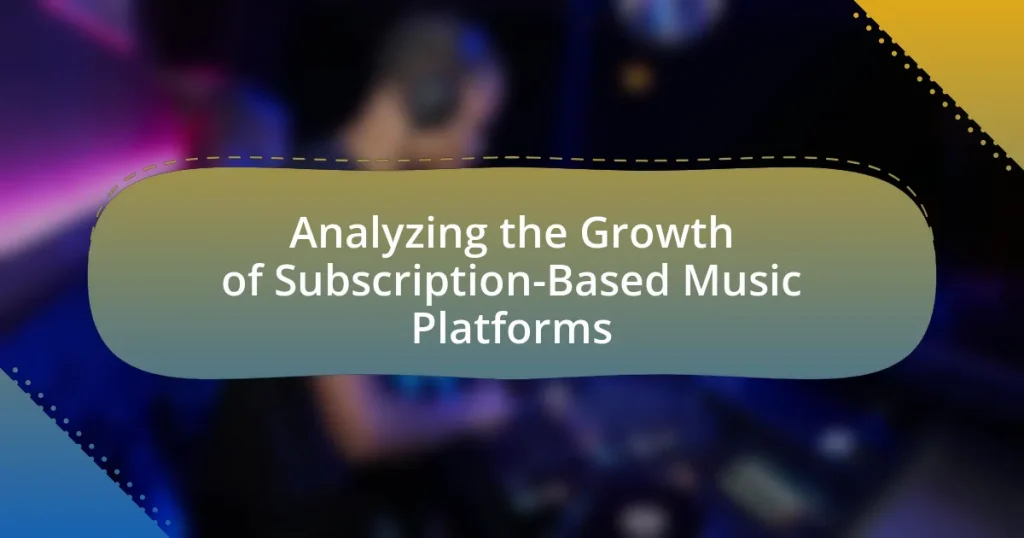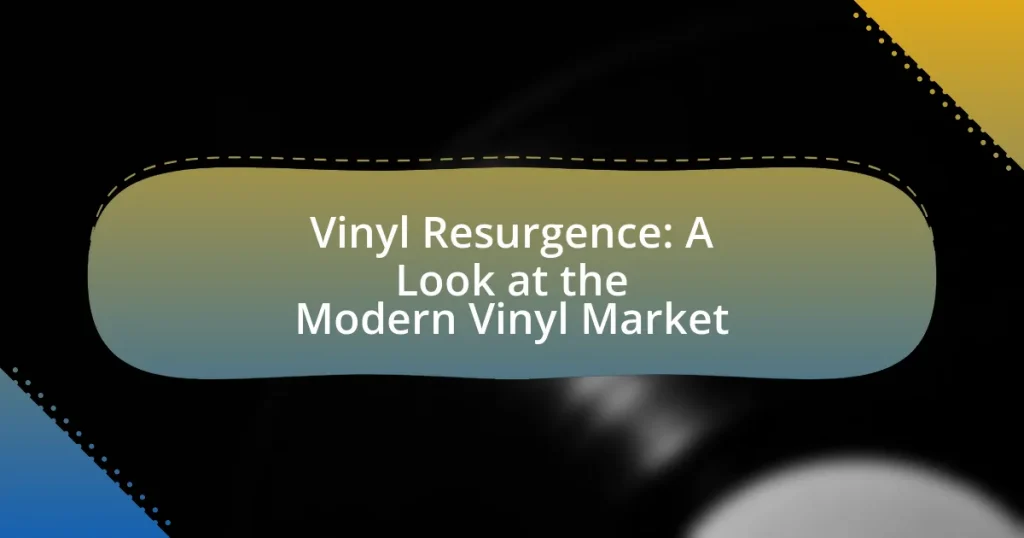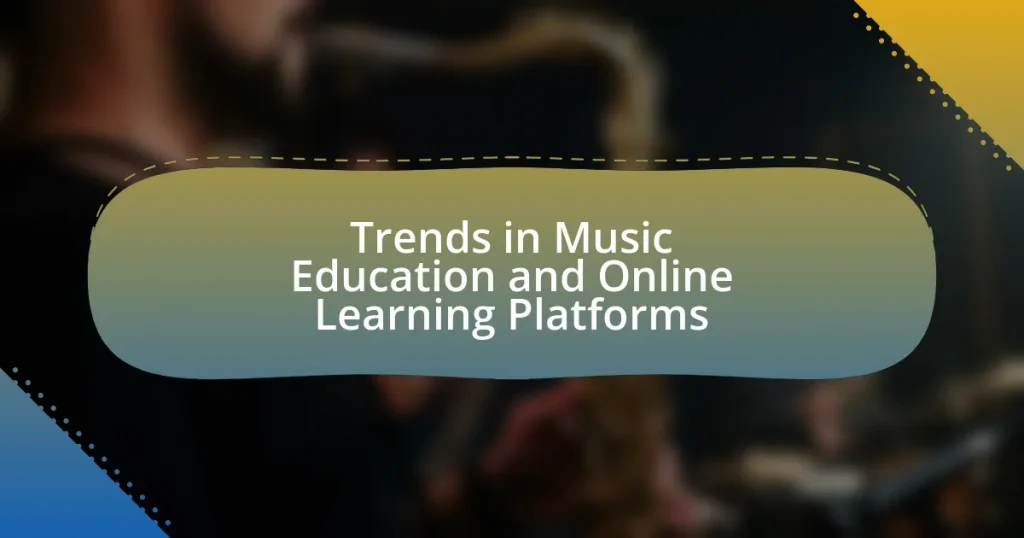Subscription-based music platforms, such as Spotify, Apple Music, and Amazon Music Unlimited, provide users with access to extensive music libraries for a recurring fee, marking a significant shift from traditional music purchasing methods. These platforms operate on a freemium model, offering both free and premium tiers, and generate revenue primarily through subscription fees, which are distributed to artists based on streaming numbers. The article explores the key features, operational mechanisms, and economic impacts of these platforms, highlighting their role in transforming music consumption trends and the challenges they face in a competitive market. Additionally, it examines future trends, including technological advancements and emerging markets, that present growth opportunities for subscription-based music services.
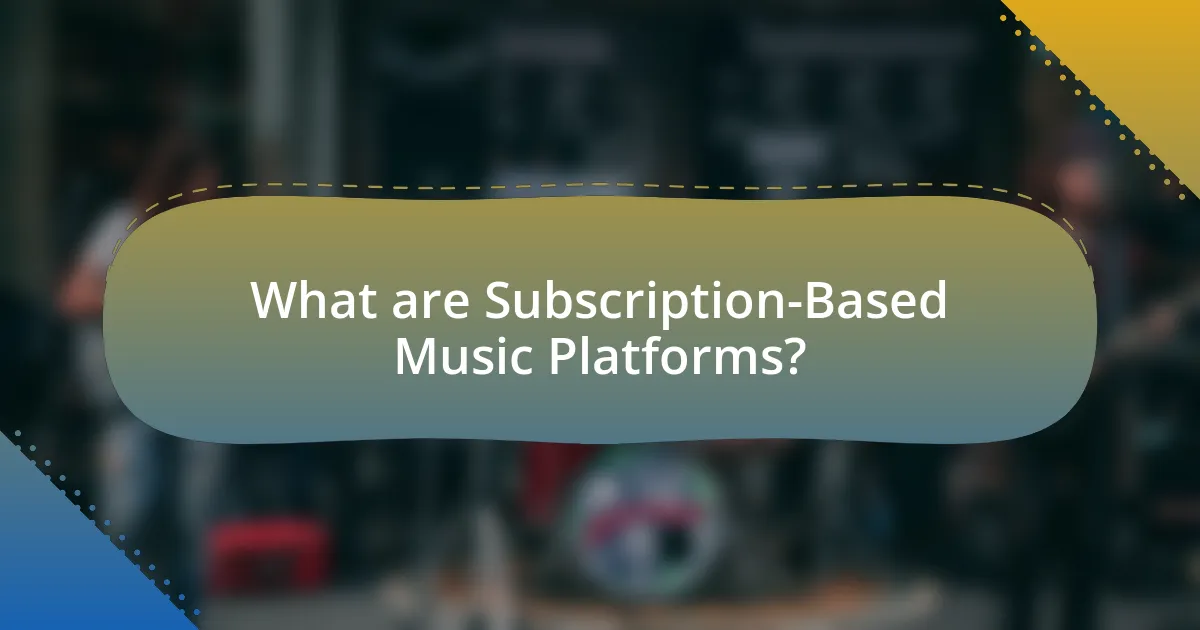
What are Subscription-Based Music Platforms?
Subscription-based music platforms are digital services that provide users access to a vast library of music for a recurring fee. These platforms, such as Spotify, Apple Music, and Amazon Music Unlimited, typically offer features like ad-free listening, offline downloads, and personalized playlists. The subscription model has gained popularity, with the global music streaming market projected to reach $23.5 billion by 2023, indicating a significant shift from traditional music purchasing methods to streaming services.
How do Subscription-Based Music Platforms operate?
Subscription-based music platforms operate by offering users access to a vast library of music for a recurring fee, typically on a monthly or annual basis. These platforms, such as Spotify and Apple Music, utilize a freemium model where users can choose between a free tier with ads and a premium tier without ads, which enhances user experience.
The platforms generate revenue primarily through subscription fees, which are then distributed to artists, record labels, and rights holders based on the number of streams and contractual agreements. For instance, Spotify reported in 2022 that it had over 400 million users, with 188 million of those being paid subscribers, illustrating the effectiveness of this business model in attracting and retaining users.
What are the key features of Subscription-Based Music Platforms?
Subscription-based music platforms primarily offer unlimited access to a vast library of songs and albums for a monthly fee. These platforms typically feature personalized playlists and recommendations based on user listening habits, enhancing user experience and engagement. Additionally, they provide offline listening capabilities, allowing users to download music for playback without an internet connection. Many subscription services also include high-quality audio streaming options, catering to audiophiles. Furthermore, these platforms often feature exclusive content, such as artist interviews and live performances, which can attract and retain subscribers. According to a report by the Recording Industry Association of America, subscription services accounted for 83% of the U.S. music industry’s revenue in 2020, highlighting their significance in the market.
How do users access content on these platforms?
Users access content on subscription-based music platforms primarily through mobile applications and web browsers. These platforms, such as Spotify and Apple Music, require users to create accounts, after which they can stream music, create playlists, and discover new content. According to a report by the Recording Industry Association of America, as of 2022, over 80% of music revenue in the U.S. came from streaming, highlighting the prevalence of these access methods.
Why have Subscription-Based Music Platforms gained popularity?
Subscription-based music platforms have gained popularity due to their convenience, extensive music libraries, and personalized user experiences. These platforms, such as Spotify and Apple Music, offer users access to millions of songs on-demand, eliminating the need for physical media or downloads. According to a report by the Recording Industry Association of America (RIAA), subscription revenue in the U.S. music industry grew by 23% in 2020, highlighting the increasing consumer preference for streaming services. Additionally, features like curated playlists and algorithm-driven recommendations enhance user engagement, making these platforms more appealing compared to traditional music consumption methods.
What factors contribute to the rise of Subscription-Based Music Platforms?
The rise of Subscription-Based Music Platforms is primarily driven by consumer demand for convenience and access to vast music libraries. As of 2023, over 500 million people globally subscribe to music streaming services, reflecting a shift from ownership to access. This trend is supported by advancements in technology, such as improved internet speeds and mobile device capabilities, which facilitate seamless streaming experiences. Additionally, the appeal of personalized playlists and algorithm-driven recommendations enhances user engagement, making these platforms more attractive. The industry’s transition from physical sales to digital subscriptions has also been accelerated by the decline of piracy, as legal streaming options provide a more appealing alternative.
How do consumer preferences influence the growth of these platforms?
Consumer preferences significantly influence the growth of subscription-based music platforms by driving demand for personalized and convenient music experiences. As listeners increasingly favor on-demand access to vast music libraries, platforms like Spotify and Apple Music have expanded their offerings to include curated playlists, algorithm-driven recommendations, and exclusive content. According to a report by the Recording Industry Association of America, subscription revenue in the music industry grew by 23% in 2020, largely due to consumer preference for streaming services over traditional purchasing methods. This shift indicates that platforms must continuously adapt to evolving consumer tastes, such as the desire for social sharing features and high-quality audio, to sustain growth and attract new subscribers.
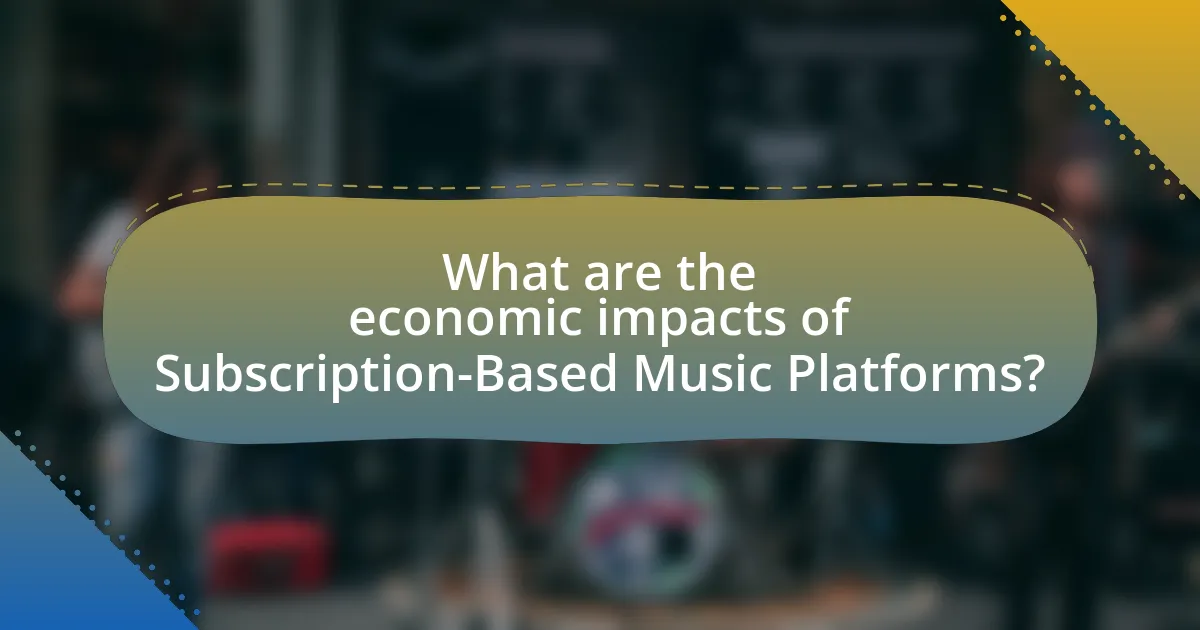
What are the economic impacts of Subscription-Based Music Platforms?
Subscription-based music platforms significantly impact the economy by generating substantial revenue for the music industry, enhancing artist income, and influencing consumer spending patterns. In 2022, global revenue from subscription music services reached approximately $12 billion, accounting for over 60% of total recorded music revenue, according to the International Federation of the Phonographic Industry (IFPI). This shift towards subscriptions has allowed artists to earn more through streaming royalties compared to traditional sales, as platforms like Spotify and Apple Music distribute funds based on user engagement rather than fixed sales. Additionally, these platforms have altered consumer behavior, leading to increased spending on music subscriptions while reducing physical music purchases, thus reshaping the overall market dynamics in the music industry.
How do Subscription-Based Music Platforms affect the music industry?
Subscription-based music platforms significantly transform the music industry by altering revenue models and consumer access. These platforms, such as Spotify and Apple Music, provide artists with a steady income stream through royalties based on streaming numbers, which has shifted the focus from album sales to single tracks and playlists. According to the Recording Industry Association of America (RIAA), streaming accounted for 83% of the U.S. music industry’s revenue in 2020, highlighting the dominance of subscription services. This shift has also democratized music distribution, allowing independent artists to reach global audiences without traditional label support, thus fostering a more diverse music landscape.
What changes have occurred in revenue models due to these platforms?
Subscription-based music platforms have shifted revenue models from traditional sales and advertising to recurring subscription fees. This transition has led to a more predictable revenue stream for artists and platforms, as evidenced by the increase in global subscription revenue from $1.5 billion in 2015 to over $23 billion in 2022, according to the International Federation of the Phonographic Industry (IFPI). Additionally, these platforms have introduced tiered subscription levels, allowing users to choose plans that suit their needs, further diversifying revenue sources.
How do Subscription-Based Music Platforms impact artists and creators?
Subscription-based music platforms significantly impact artists and creators by providing a steady revenue stream through royalties based on the number of streams. This model allows artists to earn income even from casual listeners, as opposed to traditional sales where revenue is primarily generated from album purchases. According to a report by the International Federation of the Phonographic Industry (IFPI), streaming accounted for 62.1% of global recorded music revenue in 2020, highlighting the financial importance of these platforms for artists. Additionally, subscription services often offer artists greater exposure to a wider audience, enabling them to reach listeners who may not have discovered their music otherwise. This increased visibility can lead to more concert ticket sales and merchandise purchases, further enhancing their overall income.
What role do Subscription-Based Music Platforms play in music consumption trends?
Subscription-based music platforms significantly influence music consumption trends by providing users with on-demand access to vast libraries of music for a fixed monthly fee. This model has shifted consumer behavior from purchasing individual tracks or albums to streaming music, leading to a decline in physical sales and digital downloads. According to the Recording Industry Association of America (RIAA), subscription streaming revenue accounted for 83% of total U.S. recorded music revenue in 2022, illustrating the dominance of this model in the market. Furthermore, platforms like Spotify and Apple Music have personalized user experiences through algorithms and curated playlists, enhancing user engagement and encouraging more frequent listening. This shift not only reflects changing consumer preferences but also drives the music industry towards a more data-driven approach in marketing and artist promotion.
How have listening habits changed with the advent of Subscription-Based Music Platforms?
Listening habits have shifted significantly with the advent of subscription-based music platforms, leading to increased accessibility and personalization of music consumption. Users now prefer on-demand streaming services, which allow them to listen to a vast library of songs without the need for ownership, contrasting with previous models that relied on purchasing individual tracks or albums. According to a report by the Recording Industry Association of America (RIAA), subscription streaming revenue grew by 18% in 2020, indicating a strong consumer preference for these platforms. This shift has also resulted in a decline in physical music sales and digital downloads, as consumers favor the convenience and variety offered by services like Spotify and Apple Music.
What demographic shifts are evident in the user base of these platforms?
The user base of subscription-based music platforms is experiencing significant demographic shifts, particularly with an increase in younger audiences. Research indicates that as of 2023, approximately 60% of users on platforms like Spotify and Apple Music are aged between 18 and 34, reflecting a trend towards younger demographics engaging more with digital music services. This shift is supported by data from the Recording Industry Association of America, which shows that streaming revenue has grown by over 30% annually, driven largely by this younger user base. Additionally, there is a notable increase in diversity among users, with platforms reporting higher engagement from various ethnic groups, particularly among Hispanic and Black listeners, who have shown a preference for streaming over traditional music consumption methods.
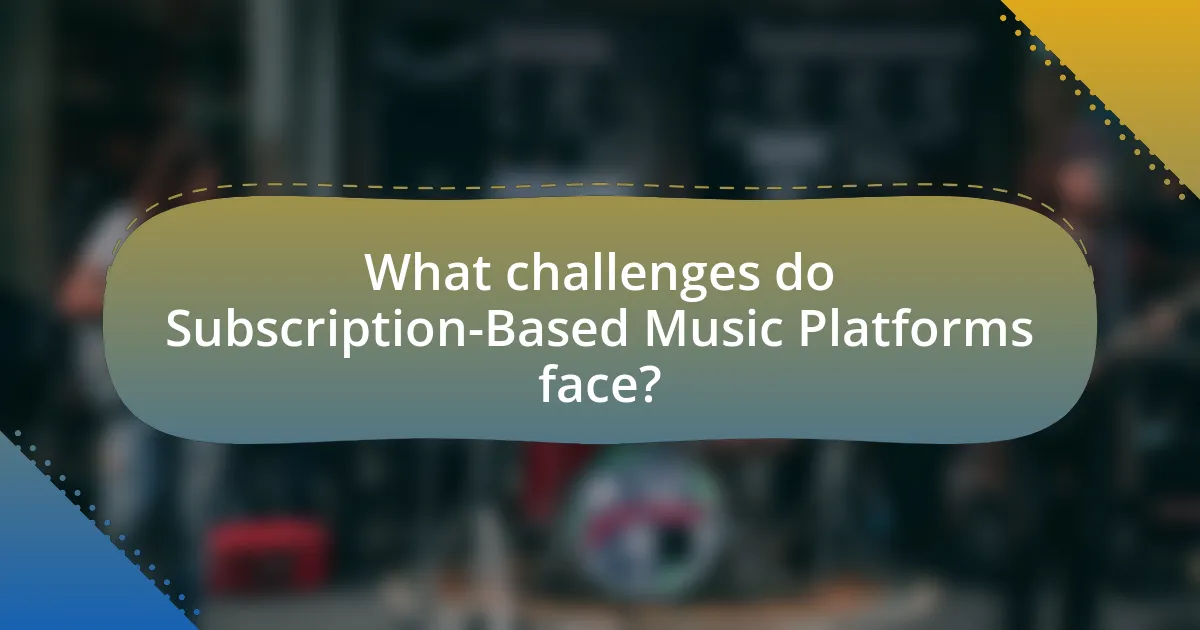
What challenges do Subscription-Based Music Platforms face?
Subscription-based music platforms face significant challenges including intense competition, user retention, and profitability. The market is saturated with numerous services like Spotify, Apple Music, and Amazon Music, making it difficult for any single platform to stand out. User retention is another critical issue, as consumers often switch between services for better deals or exclusive content, leading to high churn rates. Additionally, profitability remains elusive due to high licensing costs and the need to continually invest in technology and content to attract and retain subscribers. According to a report by the International Federation of the Phonographic Industry, the global recorded music market grew by 7.4% in 2020, yet many platforms still struggle to achieve sustainable profit margins due to these ongoing challenges.
How do Subscription-Based Music Platforms address competition?
Subscription-based music platforms address competition by enhancing user experience through exclusive content, personalized recommendations, and competitive pricing strategies. For instance, platforms like Spotify and Apple Music invest in original podcasts and exclusive album releases to attract and retain subscribers. Additionally, they utilize advanced algorithms to provide tailored playlists, which increases user engagement and satisfaction. Competitive pricing, including family plans and student discounts, further helps these platforms to appeal to a broader audience. According to a report by Statista, as of 2023, Spotify holds a 31% market share, demonstrating the effectiveness of these strategies in maintaining a leading position in a competitive landscape.
What strategies are employed to retain subscribers?
To retain subscribers, subscription-based music platforms employ strategies such as personalized content recommendations, exclusive access to new releases, and loyalty rewards programs. Personalized content recommendations enhance user engagement by utilizing algorithms that analyze listening habits, leading to a more tailored experience. Exclusive access to new releases creates a sense of urgency and value, encouraging subscribers to remain active. Loyalty rewards programs incentivize long-term subscriptions by offering discounts or additional features based on subscription duration. These strategies are supported by industry data indicating that platforms utilizing personalization see a 30% increase in user retention rates, demonstrating their effectiveness in maintaining subscriber loyalty.
How do platforms differentiate themselves in a crowded market?
Platforms differentiate themselves in a crowded market by offering unique features, tailored user experiences, and exclusive content. For instance, subscription-based music platforms like Spotify and Apple Music utilize algorithms to provide personalized playlists and recommendations, enhancing user engagement. Additionally, platforms may secure exclusive artist partnerships or unique content, such as live performances or podcasts, which attract subscribers. According to a 2021 report by the International Federation of the Phonographic Industry, platforms that invest in exclusive content see a significant increase in user retention and subscription growth, demonstrating the effectiveness of these differentiation strategies.
What are the future trends for Subscription-Based Music Platforms?
Future trends for subscription-based music platforms include increased personalization through AI-driven recommendations, enhanced user engagement via interactive features, and the integration of social media functionalities. AI technology is expected to refine music discovery, with platforms like Spotify already utilizing algorithms to tailor playlists to individual preferences. Additionally, platforms are likely to incorporate live streaming and virtual events, as evidenced by the success of initiatives like Twitch Music, which have gained traction during the pandemic. Furthermore, subscription models may evolve to include tiered pricing structures, offering exclusive content and experiences, as seen with platforms like Apple Music and Tidal, which provide high-fidelity audio options. These trends indicate a shift towards creating more immersive and personalized user experiences in the subscription-based music industry.
How might technology influence the evolution of these platforms?
Technology will significantly influence the evolution of subscription-based music platforms by enhancing user experience through advanced algorithms and data analytics. These platforms utilize machine learning to personalize music recommendations, which increases user engagement and retention. For instance, Spotify’s algorithm analyzes user listening habits to curate personalized playlists, resulting in over 40% of users discovering new music through these recommendations. Additionally, advancements in streaming technology, such as higher audio quality and faster download speeds, will further improve accessibility and user satisfaction, driving growth in subscriptions. The integration of artificial intelligence in content creation and curation will also shape the future landscape, allowing platforms to offer unique and tailored content that meets diverse listener preferences.
What emerging markets present opportunities for growth?
India and Southeast Asia present significant opportunities for growth in subscription-based music platforms. The rapid increase in smartphone penetration, with India projected to reach over 1 billion smartphone users by 2026, creates a larger audience for digital music services. Additionally, the region’s young demographic, with over 50% of the population under 30, is more inclined to adopt streaming services. According to a report by Statista, the music streaming market in India is expected to grow at a compound annual growth rate (CAGR) of 20.5% from 2021 to 2025, indicating strong potential for subscription-based models.
What best practices can be adopted by Subscription-Based Music Platforms?
Subscription-based music platforms can adopt several best practices to enhance user experience and drive growth. First, offering personalized recommendations through advanced algorithms can significantly improve user engagement; studies show that personalized playlists increase listening time by up to 30%. Second, ensuring a seamless user interface across devices enhances accessibility, as 70% of users prefer platforms that provide a consistent experience on mobile and desktop. Third, implementing flexible subscription models, such as family plans or student discounts, can attract a broader audience; for instance, platforms that offer tiered pricing have seen a 20% increase in subscriptions. Lastly, investing in exclusive content, such as artist interviews or live performances, can differentiate a platform in a competitive market, as exclusive content has been linked to a 15% increase in subscriber retention rates.










